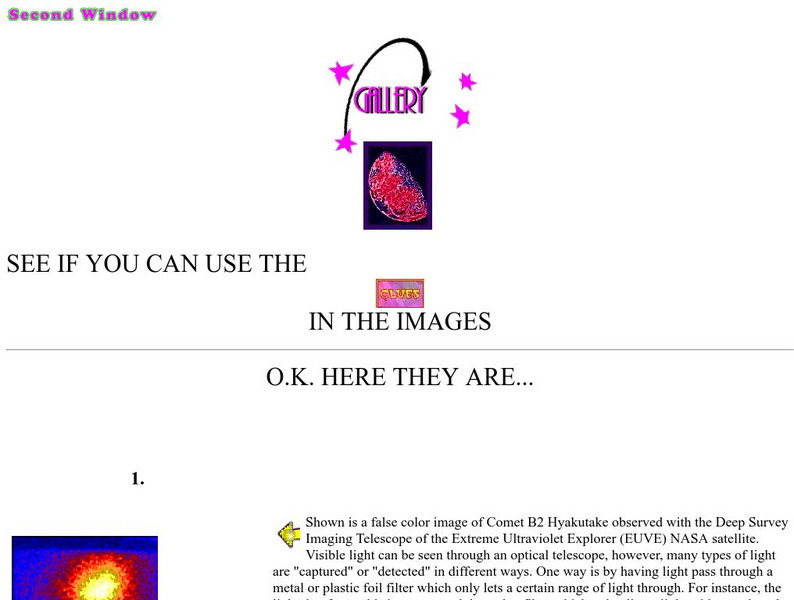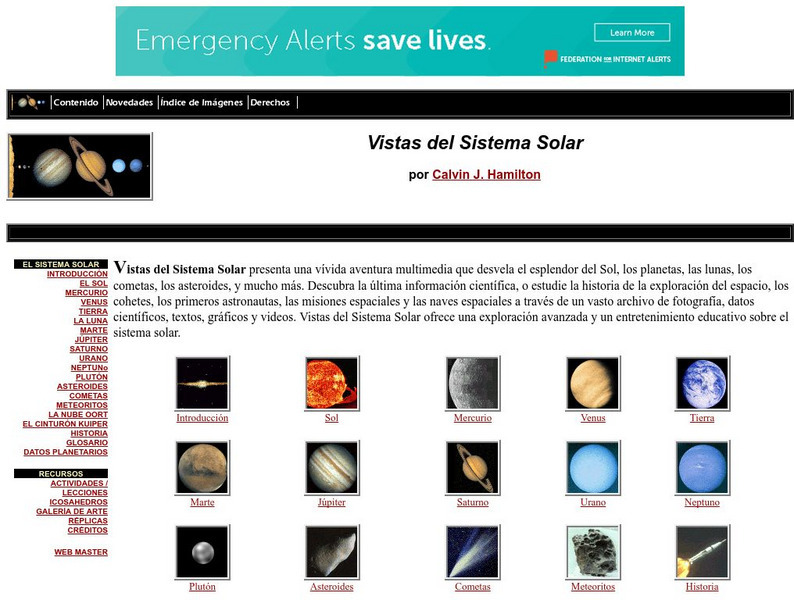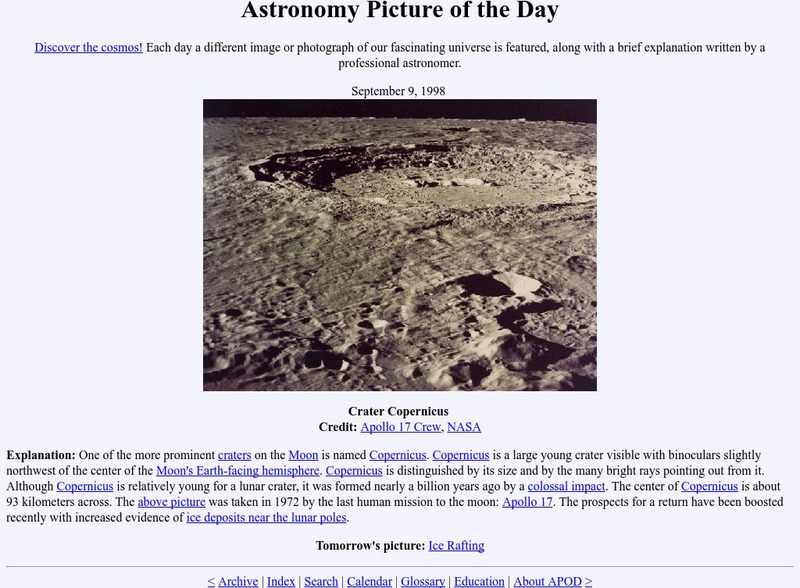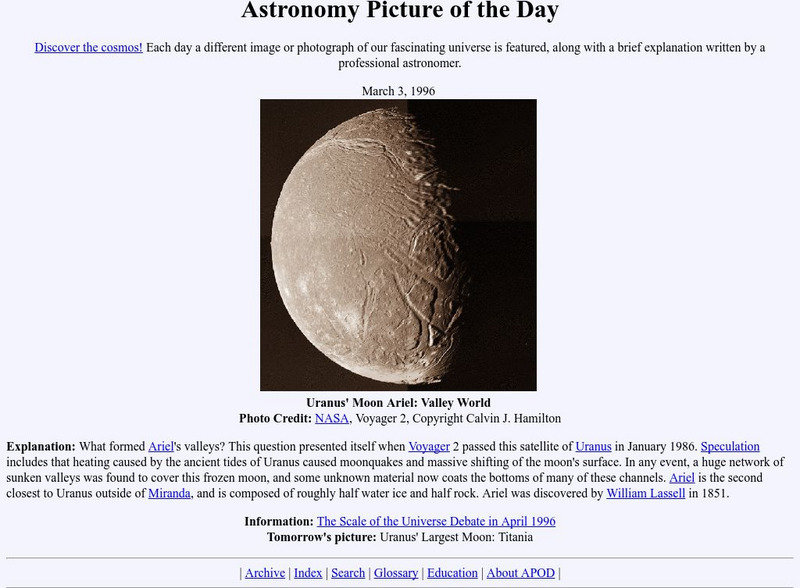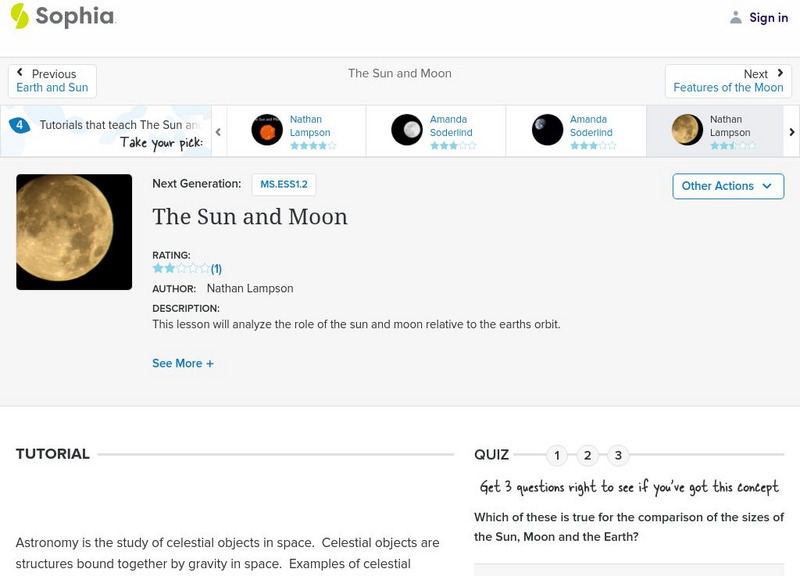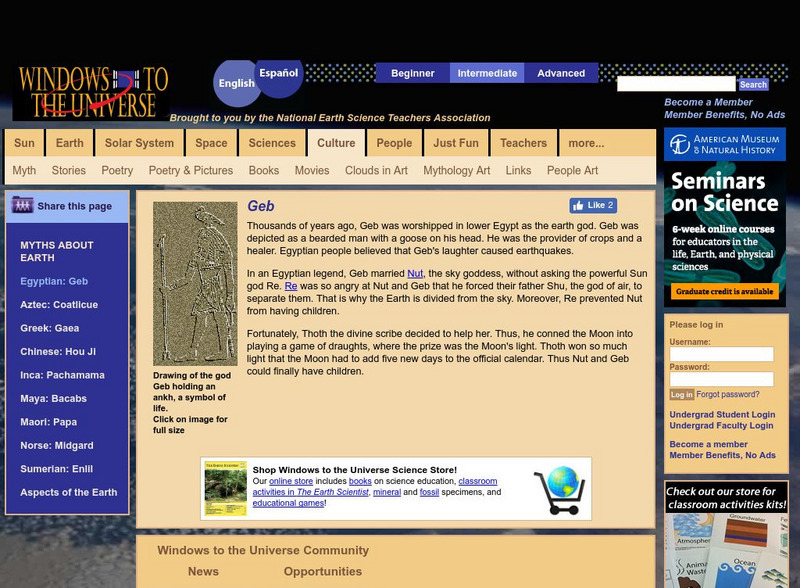US Navy
Astronomical Applications Department: Complete Sun and Moon Data for One Day
You can obtain the times of sunrise, sunset, moonrise, moonset, transits of the Sun and Moon, and the beginning and end of civil twilight, along with information on the Moon's phase by specifying the date and location in one of the two...
University of California
Center for Science Education: Gallery
A gallery of astronomy images which depict galaxies, comets, the moon, planets, nebulae, supernovae as seen in various regions of the electromagnetic spectrum. Each image in the gallery is described. Fascinating!
Science and Mathematics Initiative for Learning Enhancement (SMILE)
Smile: Models of the Earth and Moon
This lesson plan from the Illinois Institute of Technology demonstrates the causes of; day and night, seasons, and phases of the moon.With a few items, you help the elementary student discover why these phenomena occur.
University of Hawai'i
The Hawai`i Space Grant Consortium: Lunar Images
Part of the Exploring Planets in the Classroom series, this site provides images of the Moon, with Latitude and Longitude reference lines.
University of Wisconsin
The Why Files: Cosmic Consummation
After a dramatic introduction to the "Love affair," between Earth and Theia, this site gives support to the claim that the moon was created by a collision between these two planets. Also contains a brief bibliography.
Ministerio de Educación (Spain)
Ntic: Astronomia Visible
In this site you can learn about stars, planets, satellites and a little history of Astronomy.
PBS
Nova: Lunar Puzzlers
See if you can answer 4 challenging questions that will require you to take a lunar perspective. These questions deal with the way things look from the moon.
Other
Lunar Eclipses for Beginners
What is a lunar eclipse? What causes eclipses? How often do eclipses happen and when is the next lunar eclipse? You'll find the answers to these questions and more on this site on lunar eclipses.
Other
Kid Power: Astronomy for Kids
Young children can find facts about the Solar System, the Sun, meteorites, stars, galaxies, planets, our moon, comets, asteroids, and space exploration. Pages offer clear photos and bullet-point information, which is easy to read and...
Other
Phy6: De Astronomos a Astronaves
This site contains four main categories: Astronomy of the Earth's motion in space, Newtonian mechanics, the sun and spaceflight and spacecraft.
Views of the Solar System
Solarviews: Vista Del Sistema Solar
This site offers an exploration and educational entertainment about the solar system. You will be able to study the history of the exploration of space, rockets, the first astronauts, space missions through a large archive of photos,...
NASA
Nasa: Astronomy Picture of the Day: Crater Copernicus
This Astronomy Picture of the Day is of Crater Copernicus, taken by the Apollo 17 crew in 1972.
NASA
Nasa: Astronomy Picture of the Day: Uranus's Moon Oberon
Brief overview of Oberon, the most distant and second largest moon of Uranus. Includes its discovery and also a few pictures. A NASA picture of the day.
NASA
Nasa: Astronomy Picture of the Day: Uranus's Moon Ariel
Provides a brief overview of Ariel, one of Uranus's moons. Details how its deep valleys were formed. A NASA astronomy picture of the day.
Sophia Learning
Sophia: The Sun and Moon: Lesson 3
This lesson will analyze the role of the sun and moon relative to the earth's orbit. It is 3 of 4 in the series titled "The Sun and Moon."
Sophia Learning
Sophia: The Sun and Moon: Lesson 4
This lesson will analyze the role of the sun and moon relative to the earth's orbit. It is 4 of 4 in the series titled "The Sun and Moon."
Physics4kids
Physics 4 Kids: General Physics
This website will teach you about heliosphere, heliopause, stars, the moon and orbits.
Ducksters
Ducksters: Astronomy for Kids: Space Exploration Timeline
Kids learn about the timeline of the history of space exploration including early astronomy, astronauts, spacecraft, planets, and the Moon.
ClassFlow
Class Flow: Phases of the Moon
[Free Registration/Login Required] This flipchart demonstrates how the positions of the Earth, Moon and Sun cause phases of the Moon. It also illustrates the positions of the Earth, Moon, and Sun during a day and a month's time.
ClassFlow
Class Flow: Phases of the Moon
[Free Registration/Login Required] This is a one page flipchart that reviews the phases of the moon.
National Earth Science Teachers Association
Windows to the Universe: Geb
This article outlines the ancient Egyptian myth in which Geb, the Earth god, and Nut, the sky goddess, marry without the approval of the powerful Sun god, Re.
ClassFlow
Class Flow: Calendar
[Free Registration/Login Required] The history of our calendar is presented through the passage of time with complete cycles of seasons in ancient history providing a starting place. Complete cycles of seasons are discussed and the...
ClassFlow
Class Flow: Earth, Sun and Moon
[Free Registration/Login Required] In this unit children learn about the shapes and relative sizes of the Earth, Sun and Moon. Using models they learn how the three bodies move relative to each other and how these movements relate to...
ClassFlow
Class Flow: Moon Phases
[Free Registration/Login Required] This flipchart is a discussion of the moon and its phases.



